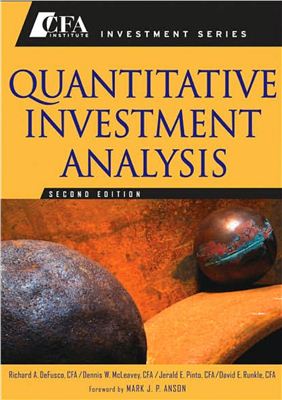John Wiley and Sons, 2007. ISBN-10: 0470052201 As part of the CFA
Institute Investment Series, the Second Edition of Quantitative
Investment Analysis has been designed for a wide range of
individuals, from graduate-level students focused on finance to
practicing investment professionals. This globally relevant guide
will help you understand quantitative methods and apply them to
today's investment process.
In this latest edition, the distinguished team of Richard DeFusco, Dennis McLeavey, Jerald Pinto, and David Runkle update information associated with this discipline; improve the presentation and coverage of several major areas, including regression, time series, and multifactor models; and introduce an even greater variety of investment-oriented examples—which reflect the changes currently taking place in the investment community. Throughout the text, special attention is paid to ensuring the even treatment of subject matter, consistency of mathematical notation, and continuity of topic coverage that is so critical to the leaing process.
Valuable for self-study and general reference, this book provides clear, example-driven coverage of a wide range of quantitative methods. Topics discussed include:
The time value of money.
Discounted cash flow applications.
Common probability distributions.
Sampling and estimation.
Hypothesis testing.
Correlation and regression.
Multiple regression and issues in regression analysis.
Time-series analysis.
Portfolio concepts.
In this latest edition, the distinguished team of Richard DeFusco, Dennis McLeavey, Jerald Pinto, and David Runkle update information associated with this discipline; improve the presentation and coverage of several major areas, including regression, time series, and multifactor models; and introduce an even greater variety of investment-oriented examples—which reflect the changes currently taking place in the investment community. Throughout the text, special attention is paid to ensuring the even treatment of subject matter, consistency of mathematical notation, and continuity of topic coverage that is so critical to the leaing process.
Valuable for self-study and general reference, this book provides clear, example-driven coverage of a wide range of quantitative methods. Topics discussed include:
The time value of money.
Discounted cash flow applications.
Common probability distributions.
Sampling and estimation.
Hypothesis testing.
Correlation and regression.
Multiple regression and issues in regression analysis.
Time-series analysis.
Portfolio concepts.

